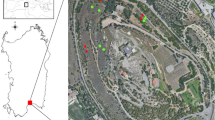Abstract
The population structure and standing crop of the desert shrubThymelaea hirsuta (L.) Endl. were evaluated in six different habitats in the western Mediterranean desert of Egypt. Under favourable conditions, populations ofT. hirsuta are denser and the size structure has a strong bias towards small, juvenile individuals, whereas the reverse tendency is found under adverse conditions with size structure biased towards big individuals. These results are discussed in the light of hypothesis of intraspecific competition. The standing crop is strongly affected by soil salinity and nature of soil surface (amount of exposed rocks).
Similar content being viewed by others
References
Ayyad, M. A. & Ammar, M. Y. 1974. Vegetation and environment of the western Mediterranean coastal land of Egypt. II. The habitat of inland ridges. J. Ecol. 62: 439–456.
Ayyad, M. A. & El-Ghareeb, R. E. 1982. Salt marsh vegetation of the western Mediterranean desert of Egypt. Vegetatio 49: 3–19.
Ayyad, M. A. & Le Floc'h, E. 1983. An ecological assessment of renewable resources for rural agricultural development in the western Mediterranean coastal region of Egypt. Case study: El Omyed test area. REMDENE Project (Alexandria), Centre L. Emberger (Montpellier), ORSTOM (Paris).
Barbour, M. G. 1969. Age and space distribution of the desert shrubLarrea divaricata. Ecology 50: 679–685.
Caswell, H. 1986. Life cycle models for plants. Lectures on Mathematics in the Life Sciences 18: 171–233.
Crisp, M. D. & Lange, R. T. 1976. Age structure, distribution and survival under grazing of the arid-zone shrubAcacia burkitti. Oikos 27: 86–92.
El-Ghonemy, A. A., Shaltout, K., Valentine, W. & Wallace, A. 1977. Distributional pattern ofThymelaea hirsuta (L.) Endl. and associated species along the Mediterranean coast of Egypt. Bot. Gaz. 138: 479–489.
El-Ghonemy, A. A. & Tadros, T. M. 1970. Sociological studies of the natural plant communities along a transect 200 km long between Alexandria and Cairo. Bull. Fac. Sci. Alexandria University 10.
El-Ghonemy, A. A., Wallace, A. & Romney, E. M. 1980. Frequency distribution of numbers of perennial shrubs in the northern Mojave desert. Great Basin Nat. Mem. 40: 34–38.
El-Kady, H. F. 1987. A study of range ecosystems of the western Mediterranean coastal desert of Egypt. Thesis Technical University, Berlin.
Emberger, L. 1955. Une classification biogéographique des climats. Recueil des Travaux du Laboratoire de Botanique, Géologie et Zoologie de la Faculté des Sciences de l'Université de Montpellier 7: 3–43.
Floret, C., Le, Floc'h, E., & Pontanier, R. 1983. Phytomasse et production vegetale en Tunisie Presaharienne. Acta Ecologica Ecol. Plant. 4: 133–152.
Goldberg, D. E. & Turner, R. M. 1986. Vegetation change and plant demography in permanent plots in the Sonoran desert. Ecology 67: 695–712.
Goldsmith, F. B. & Smart, N. 1982. Age, spacing and growth rate ofTamarix as an indication of lake boundary fluctuations at Sebkhet Kelbia, Tunisia. J. Arid Environm. 5: 43–51.
Harper, J. L. 1977. Population biology of plants. Academic Press, London.
Harper, J. L. & White, J. 1974. The demography of plants. Ann. Rev. Ecol. Syst. 5: 419–463.
Kirkpatrick, M. 1984. Demographic models based on size, not age, for organisms with indeterminate growth. Ecology 65: 1874–1884.
Leak, W. B. 1965. The J-shaped probability distribution. Forest Science 11: 405–409.
Meigs, P. 1973. World distribution of coastal desert. In: H. K., David & A. Z., Wiloon (eds), Coastal deserts. Their natural and human environment. Univ. of Arizona Press, Tuscon.
Migahid, A. M., Abd El-Rahman, A. A., El-Shafei, A. M. & Hammouda, M. A. 1955. Types of habitats and vegetation of Ras El-Hikma. Bull Inst. Desert Egypte 5: 107–190.
Mithen, R., Harper, J. L. & Weiner, J. 1984. Growth and mortality of individual plants as a function of ‘available area’, Oecologia 62: 57–60.
Moore, P. D. & Bhadresa, R. 1978. Population structure, biomass and pattern in a semi-desert shrubZygophyllum eurypterum, in the Turan biosphere reserve of north-eastern Iran. J. Appl. Ecol. 15: 837–845.
Rikli, M. 1943. Das Pflanzenkleid der Mittelmeerländer. Verlag Huber, Bern.
Rochow, J. J. 1974. Estimates of above-ground biomass and primary productivity in a Missouri forest. J. Ecol. 62: 567–577.
Schlesinger, W. H. & Gill, D. S. 1978. Demographic studies of the chaparral shrub,Ceanothus megacarpus, in the Santa Ynez mountains, California Ecology 59: 1256–1263.
Shaltout, K. H. 1983. An ecological study ofThymelaea hirsuta (L.) Endl. in Egypt. Ph. D. Thesis, Tanta University.
Shaltout, K. H. 1987. Pattern, phenology and sex ratio of EgyptianThymelaea hirsuta populations. Vegetatio 72: 67–73.
Shaltout, K. H. & El-Ghareeb, R. 1985. Effect of protection on the phytomass and primary production of ecosystems of the western Mediterranean desert of Egypt. I. Ecosystems of nonsaline depressions. Bull. Fac. Sci. Alexandria University 25: 109–131.
Tadros, T. M. & Atta, B. A. M. 1958. The plant communities of barly fields and uncultivated desert areas of Mareotis (Egypt) Vegetatio 8: 161–175.
Thalen, D. C. P. 1979. Ecology and utilization of desert shrub rangelands in Iraq. Junk Publishers, The Hague.
Watkinson, A. R. & White, J. 1985. Some life history consequences of modular construction in plants. Phil. Trans. R. Soc. London B 313: 31–51.
Weiner, J. 1984. Neighbourhood interference amongstPinus rigida individuals. J. Ecol. 72: 183–195.
Weiner, J. 1985. Size hierarchies in experimental populations of annual plants. Ecology 66: 743–752.
Weiner, J. 1986. How competition for light and nutrients affects size variability inIpomoea tricolor populations. Ecology 67: 1425–1427.
Werner, P. A. & Caswell, H. 1977. Population growth rates and age vs. stage distribution models for teasel (Dipsacus sylvestris Huds.), Ecology 58: 1103–1111.
White, J. 1980. Demographic factors in populations of plants. Botanical Monographs 15: 21–47.
Author information
Authors and Affiliations
Rights and permissions
About this article
Cite this article
Shaltout, K.H., Ayyad, M.A. Structure and standing crop of EgyptianThymelaea hirsuta populations. Vegetatio 74, 137–142 (1988). https://doi.org/10.1007/BF00044738
Accepted:
Issue Date:
DOI: https://doi.org/10.1007/BF00044738




